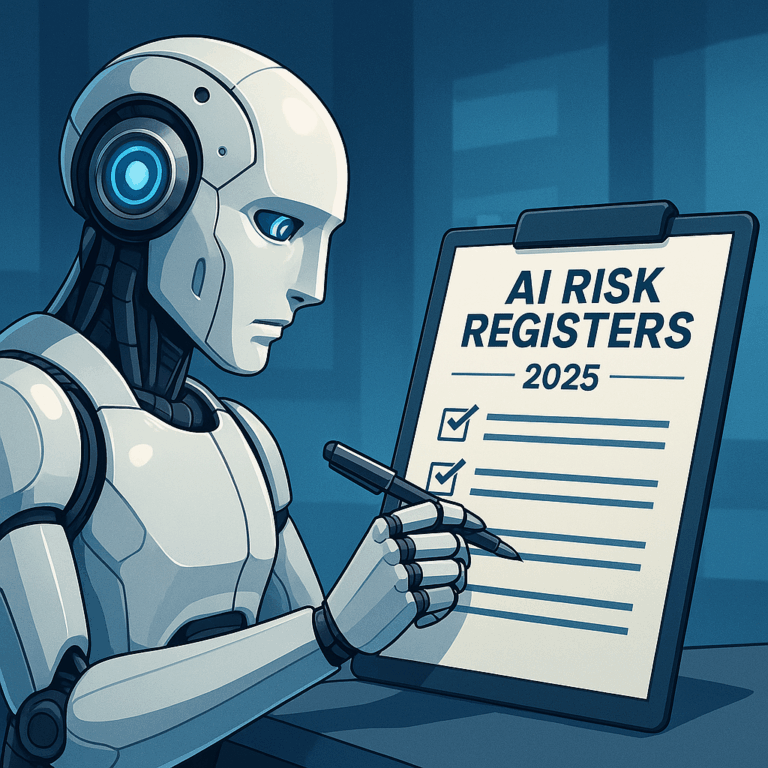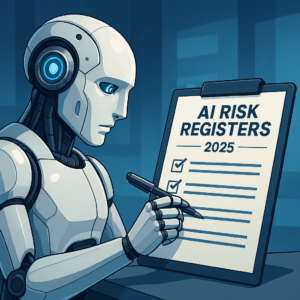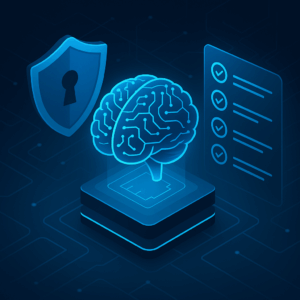Why AI Needs Its Own Risk Register
Traditional enterprise risk management (ERM) systems aren’t designed to capture the unique characteristics of AI — such as non-deterministic behavior, data dependency, and opacity (black-box models). As a result, emerging threats often slip through the cracks or are misclassified.
An AI risk register fills this gap by acting as a living document that consolidates AI-specific risks, assigns ownership, and informs governance and mitigation strategies.
“If you can’t see it, you can’t govern it.”
— This principle has never been more true than in AI risk management.
Key Elements of an AI Risk Register (2025 Edition)
Here’s what a modern AI risk register should include — and why each component matters:
1. AI Risk Category
Categorize risks to make them easier to track and escalate:
Bias and Fairness (e.g., discriminatory loan approval)
Security and Privacy (e.g., data leakage, adversarial prompts)
Model Performance (e.g., hallucinations, drift)
Regulatory and Legal (e.g., AI Act, FTC rules)
Operational Risks (e.g., overreliance, automation without validation)
2. Business Impact Rating
Evaluate potential damage:
Financial loss
Regulatory penalties
Reputational damage
Customer churn or trust erosion
Use a consistent scale (e.g., High / Medium / Low) and align it with your existing ERM framework.
3. Likelihood of Occurrence
Estimate how likely the risk is, based on:
Model complexity
Lack of testing or explainability
Exposure to unvetted third-party models
Pair this with controls maturity (e.g., strong testing = lower likelihood).
4. AI System Involved
Track which model, vendor, or application the risk is tied to:
Internal LLM-based chatbot
External generative AI used for marketing
ML-based fraud detection tool
This enables targeted escalation and accountability.
5. Risk Owner
Assign a named individual (not just a department). For example:
Data Science Lead for drift risks
Compliance Officer for regulatory risks
CISO for AI model security
6. Controls in Place
Document the mitigation measures:
Bias audits
HITL (human-in-the-loop) controls
Vendor assessments
Logging and monitoring systems
Also note gaps or control weaknesses.
7. Escalation Path
Define when and how to escalate:
Who gets notified at each risk tier?
What triggers a governance review?
What’s the role of the AI Risk Committee?
How to Operationalize the Register
Building the register is just the start. Here’s how to make it part of your ongoing governance:
🔁 Make it Dynamic
Update regularly — ideally quarterly — as new models are deployed or risks evolve. Set automated reminders or link to your model inventory.
🔍 Align with Governance Reviews
Use the risk register during:
New model approval meetings
Internal audit planning
Regulatory readiness reviews (e.g., NIST AI RMF, EU AI Act)
📊 Visualize the Risk Landscape
Create dashboards showing:
Top 10 AI risks
Risk concentration by model or department
Trend lines for new or escalating risks
This gives leadership better visibility.
Real-World Example: A Financial Services Case
A financial services firm used an AI-powered chatbot to automate customer loan inquiries. A study found that when this chatbot was used to evaluate mortgage applications, it recommended denials more often for Black applicants and Hispanic applicants, assigning them higher interest rates compared to statistically equivalent White applicants—revealing clear racial bias in its decisions – Ohio Capital Journal
Because the bank maintained an AI-specific risk register, they had proactively documented the risk as “chatbot bias in mortgage decisioning”, categorized under Bias & Fairness. That meant they already had:
Assigned ownership to the AI governance team,
Pre-planned mitigation steps (e.g. bias testing, data rebalancing),
A defined escalation protocol involving compliance and audit functions.
When the bias surfaced, they escalated it quickly, retrained the model with fairness constraints, and reviewed the chatbot’s output before further deployment—avoiding regulatory scrutiny and reputational damage.
Final Thoughts: Make the AI Risk Register Your Governance Compass
In 2025, AI systems are too impactful — and too unpredictable — to leave their risks buried inside spreadsheets or overlooked by generic risk categories. A well-maintained AI risk register not only strengthens internal governance but also helps organizations respond confidently to external audits and regulatory scrutiny.
AI governance starts with visibility. The AI risk register is your lens into what can go wrong — and how to stop it.




